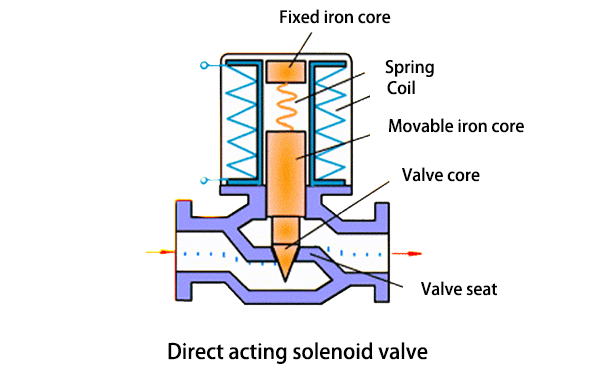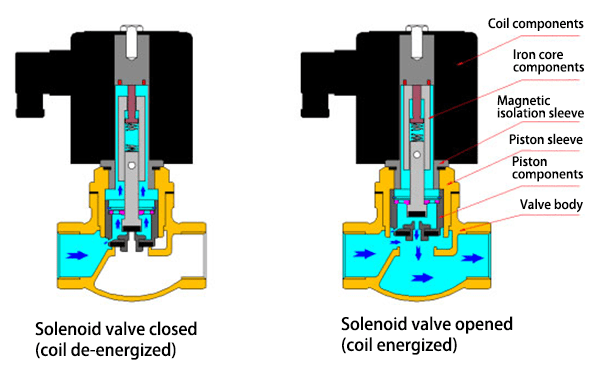
Solenoid valves are electromechanical devices that play a crucial role in controlling the flow of fluids or gases within a system. They are widely used in various industries, including manufacturing, automotive, HVAC, and agriculture, among others.
One of the key distinctions among solenoid valves is whether they are normally open (NO) or normally closed (NC). In this article, we will delve into the differences between normally open and normally closed solenoid valves, their applications, and considerations for selecting the appropriate type for specific needs.
1. Understanding Solenoid Valves
Before we dive into the specifics of normally open and normally closed solenoid valves, let's first understand how solenoid valves work.
Solenoid valves consist of a coil of wire (solenoid coil), an armature, a valve body, and a fluid or gas flow path. When an electric current is applied to the solenoid, it generates a magnetic field that attracts the armature, causing it to move and either open or close the valve.
This mechanism allows for remote and rapid control of fluid or gas flow, making solenoid valves versatile and efficient components in various applications.

2. Normally Open (NO) Solenoid Valve
2.1 What Is a Normally Open (NO) Solenoid Valve and How Does It Work
A normally open solenoid valve is designed to remain open in its default state, allowing fluid or gas to flow through the valve when no electrical power is applied to the solenoid.
When an electrical current is applied to the solenoid coil, it energizes the coil, generating a magnetic field that pulls the armature, thereby closing the valve and stopping the flow of fluid or gas.
Once the electrical power is removed, the spring inside the valve returns the armature to its original position, reopening the valve and allowing flow to resume.
2.2 Applications of Normally Open Solenoid Valves
Safety Systems: Normally open solenoid valves are commonly used in safety systems where it is critical to maintain fluid or gas flow in the event of a power failure. For example, they can be found in emergency shutdown systems in industrial plants or gas supply systems in residential buildings.
Watering Systems: In irrigation systems, normally open solenoid valves are used to control the flow of water to sprinklers or drip lines. When the irrigation system is not in operation, the valves remain open to ensure continuous water supply to the plants.
3. Normally Closed (NC) Solenoid Valve
3.1 What Is a Normally Closed (NC) Solenoid Valve and How Does It Work

Conversely, a normally closed solenoid valve is designed to remain closed in its default state, blocking the flow of fluid or gas when no electrical power is applied to the solenoid.
When electrical power is supplied to the solenoid coil, it energizes the coil, creating a magnetic field that moves the armature, thereby opening the valve and allowing fluid or gas to flow.
Once the electrical power is removed, the spring inside the valve returns the armature to its original position, closing the valve and stopping the flow.
3.2 Applications of Normally Closed Solenoid Valves
Gas and Liquid Control: Normally closed solenoid valves are commonly used in applications where it is essential to shut off the flow of gas or liquid when not in use. For example, they can be found in gas control systems, liquid dispensing machines, and pneumatic systems.
Process Automation: In manufacturing processes, normally closed solenoid valves are utilized for process automation, where precise control of fluid or gas flow is required. They can be integrated into automated machinery to regulate the flow of raw materials, chemicals, or cooling fluids.
4. Considerations for Selecting the Right Solenoid Valve

Valve Opening or Closing Time:
When the solenoid valve needs to be closed for a long time, choose the normally closed type.
When the solenoid valve needs to be open for a long time, choose the normally open type.
Sometimes the application requires the solenoid valve to be open for a long time and then closed for a long time. In this case, it should be better to choose the self-holding type solenoid valve, also called a bistable solenoid valve or a latching solenoid valve.
Application Requirements: Consider the specific requirements of your application, including the type of fluid or gas being controlled, flow rate, pressure, and temperature conditions. This will help determine whether a normally open or normally closed solenoid valve is more suitable.
Power Failure Considerations: Evaluate whether maintaining flow during a power failure is critical for your application. Normally open solenoid valves are ideal for applications where continuous flow is necessary in the absence of electrical power.
Safety Considerations: In applications where safety is paramount, such as in gas or chemical processing plants, choose solenoid valves that meet industry safety standards and regulations.
Environmental Conditions: Consider environmental factors such as moisture, temperature extremes, and corrosive substances present in the operating environment. Select solenoid valves with appropriate materials and sealing mechanisms to ensure reliable performance in challenging conditions.
Control System Compatibility: Ensure compatibility between the solenoid valve and your control system, whether it's manual, pneumatic, hydraulic, or electronic. Integration with existing control systems is essential for seamless operation and monitoring.

5. FAQs
5.1 What Happens When a Normally Closed Solenoid Valve Is Energized?
When a normally closed solenoid valve is energized, an electrical current passes through the coil, creating a magnetic field. This magnetic field then attracts the plunger or armature, pulling it against the force of a spring or other mechanism, which opens the valve. This action allows the flow of fluid or gas through the valve.
5.2 How Do You Tell if a Solenoid is Open or Closed?
Visual inspection of the valve or reading its specifications can reveal its default state. Additionally, if the solenoid is part of a system, its operational status can be determined by observing the fluid or gas flow when it's energized or de-energized.
6. Conclusion
Normally open and normally closed solenoid valves serve distinct purposes in fluid and gas control systems, with each type offering unique advantages depending on the application requirements.
Understanding the differences between these two types of solenoid valves and considering factors such as application requirements, power failure considerations, safety, environmental conditions, and control system compatibility is essential for selecting the right valve for your specific needs.
Whether it's ensuring continuous flow during a power outage or automating industrial processes with precision control, choosing the appropriate solenoid valve is critical for achieving optimal performance and efficiency in diverse applications.


